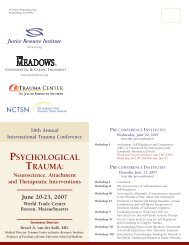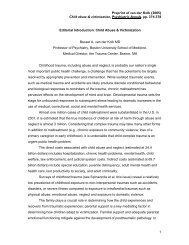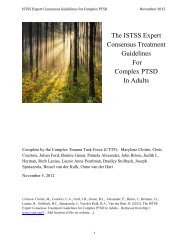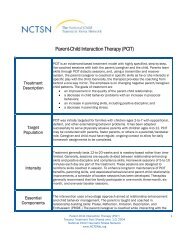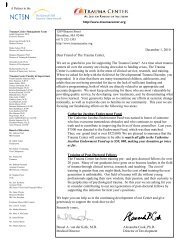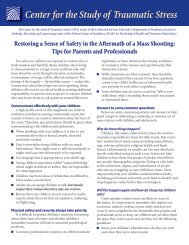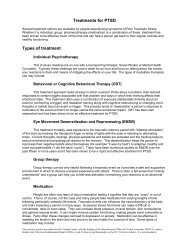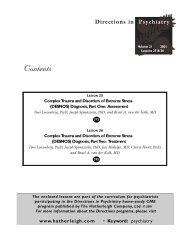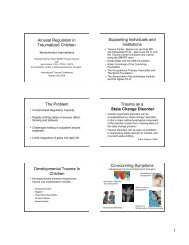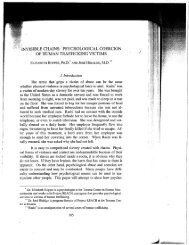in Child Welfare - The Trauma Center
in Child Welfare - The Trauma Center
in Child Welfare - The Trauma Center
You also want an ePaper? Increase the reach of your titles
YUMPU automatically turns print PDFs into web optimized ePapers that Google loves.
14 CW360 o <strong>Trauma</strong>-Informed <strong>Child</strong> <strong>Welfare</strong> Practice • W<strong>in</strong>ter 2013By What Yardstick Should We Measure Success <strong>in</strong> <strong>Child</strong> <strong>Welfare</strong> Policy?Janice L. Cooper, PhD, MPA and Yumiko Aratani, PhDOverview<strong>The</strong> last decade has seen a tremendouschange and progress <strong>in</strong> child welfare. This isparticularly true of child welfare policy. <strong>The</strong>focus on permanency, led to <strong>in</strong>creases <strong>in</strong> thepercentage of foster care children adoptedfrom 17% to 21% between 2000 and 2010(U.S. Department of Health and HumanServices Adm<strong>in</strong>istration for <strong>Child</strong>ren andFamilies, 2011). <strong>The</strong>re was a 26% decrease<strong>in</strong> the child welfare rolls from 552,000to 408,000 dur<strong>in</strong>g the same period (U.S.Department of Health and Human ServicesAdm<strong>in</strong>istration for <strong>Child</strong>ren and Families,2011). <strong>The</strong> rates of children be<strong>in</strong>g victimized(a child with maltreatment dispositionsubstantiated, <strong>in</strong>dicated, or hav<strong>in</strong>g alternativeresponse by the child welfare agencies) havedecl<strong>in</strong>ed from 12.2 to 10 per 1000 (U.S.Department of Health and Human Services,2002, 2012). Conditions of foster care alsoimproved, such as reduced average lengths ofstay from 32 months to 26 months, marg<strong>in</strong>al<strong>in</strong>creases <strong>in</strong> k<strong>in</strong>ship care (from 24% to 25%)and <strong>in</strong> non-relative foster care (from 47%to 48%), and reductions <strong>in</strong> the use of grouphomes and/or <strong>in</strong>stitutions from 18% to 15%(U.S. Department of Health and HumanServices Adm<strong>in</strong>istration for <strong>Child</strong>ren andFamilies, 2011). Dur<strong>in</strong>g the same period,there were <strong>in</strong>creases <strong>in</strong> child welfare fund<strong>in</strong>gsuch as the <strong>Child</strong> Abuse Prevention andTreatment Act, State grants, and adoption<strong>in</strong>centive payments (American HumaneAssociation, 2012). Also significant was anarrow<strong>in</strong>g <strong>in</strong> disparities marked by reductions<strong>in</strong> the proportion of African-Americanchildren <strong>in</strong> foster care from 39% to 29%(American Humane Association, 2012). Onthe other hand, the period also saw setbacks.More young children (ages 0-5), enteredfoster care, <strong>in</strong>creas<strong>in</strong>g from 29% to 36%(American Humane Association, 2012).This article focuses on the impact ofpolicy on the child welfare system (CWS)us<strong>in</strong>g another measure: the extent to which<strong>in</strong>fus<strong>in</strong>g a trauma-<strong>in</strong>formed care frameworkhas taken hold. While not every child <strong>in</strong>the CWS will experience trauma, previousresearch shows different estimates of theprevalence of post-traumatic stress disorder(PTSD) among children <strong>in</strong> the CWS, rang<strong>in</strong>gfrom 19% to 55% (Annie Casey Foundation,2011; Grasso, et al., 2009; Greeson, et al.,2011; Jackson, O’Brien, & Pecora, 2011;Kolko, et al., 2010). Nearly 12% of children<strong>in</strong> child welfare who rema<strong>in</strong>ed at home alsoexperienced PTSD (Kolko, et al., 2010).Risk factors for PTSD <strong>in</strong>clude multipleexposures to maltreatment. Over 70%of children <strong>in</strong> foster care had two or moretrauma experiences (Greeson, et al., 2011).<strong>Child</strong>ren with multiple trauma exposures tendto experience other mental health problems<strong>in</strong>clud<strong>in</strong>g depression and externaliz<strong>in</strong>gconditions (Kolko, et al., 2010; Richardson,2001). <strong>Trauma</strong> experiences have a long-termdetrimental effect on health and mental healthand susceptibility to re-traumatization(Dube,2001; Felitti, et al., 1998; Widom, Czaja, &Dutton, 2008).<strong>Trauma</strong>-<strong>in</strong>formed care and atrauma-<strong>in</strong>formed framework<strong>Trauma</strong>-<strong>in</strong>formed refers to the process ofengagement with a parent, child or familycharacterized by <strong>in</strong>tentional efforts to ensurethat no action is taken that further causesharm. It creates an environment that enablesthe victimized child or person to feel safe andpromotes the ability of the victim to cope andto <strong>in</strong>crease resiliency. A trauma-<strong>in</strong>formedframework refers to embedd<strong>in</strong>g up-to-daterobust knowledge on trauma <strong>in</strong> policy andpractice such as how to prevent trauma,address its consequences, and ensure thesystem does not contribute to re-traumatiz<strong>in</strong>g.Operationally, this would suggest policiessuch as fund<strong>in</strong>g and support<strong>in</strong>g effectivesystems for prevention and <strong>in</strong>tervention,beg<strong>in</strong>n<strong>in</strong>g with evidence-based (EB) andculturally-normed screen<strong>in</strong>g and assessmentof trauma, ensur<strong>in</strong>g the widespread adoptionof EB treatment and engagement strategies,support for tra<strong>in</strong><strong>in</strong>g with<strong>in</strong> and across childserv<strong>in</strong>gsystems, and requir<strong>in</strong>g accountabilitythroughout systems.<strong>The</strong> way forwardA 2007 National <strong>Center</strong> for <strong>Child</strong>ren <strong>in</strong>Poverty report presented the adverse impactof the child serv<strong>in</strong>g systems <strong>in</strong> America andtheir failure systematically to adopt a trauma<strong>in</strong>formedperspective <strong>in</strong> policy (Cooper,Masi, Dababnah, Aratani, & Knitzer, 2007).It addressed the need to <strong>in</strong>clude the useof EB screen<strong>in</strong>g and treatment for traumaand related mental health conditions <strong>in</strong> thechild welfare system. It called for <strong>in</strong>creasedWe offer the follow<strong>in</strong>g recommendations to support improved practice andbetter outcomes.• Mandate EB trauma screen<strong>in</strong>g at all entry po<strong>in</strong>ts <strong>in</strong>to child welfare and atdischarge• Require that child and adolescent trauma histories are <strong>in</strong>tegral to theirconfidential records available at all entry po<strong>in</strong>ts to the care delivery systemand that <strong>in</strong>dividualized care plann<strong>in</strong>g address the child and family needs <strong>in</strong> atrauma-<strong>in</strong>formed manner• Ensure that trauma-<strong>in</strong>formed care is <strong>in</strong>tegrated <strong>in</strong>to the pre-service tra<strong>in</strong><strong>in</strong>gand cont<strong>in</strong>u<strong>in</strong>g education for all child welfare professionals and paraprofessionals• Set up systems to better identify and match staff suitable for work<strong>in</strong>g <strong>in</strong> theCWS, reward and support them appropriately and recognize the need for thehuman resource development plan to be trauma-<strong>in</strong>formed.• Increase fund<strong>in</strong>g and tie it not only to reduction <strong>in</strong> child welfare rolls butimproved outcomes such as child and family health and mental health.• Develop guidel<strong>in</strong>es for regulations and/or certification perta<strong>in</strong><strong>in</strong>g to traumaexpertise.• Fund <strong>in</strong>itiatives that support staff who work with children and youth whoexperienced trauma and reduce secondary trauma associated with traumarelatedwork.• Partner with tribal and other colleges that target specific populations todevelop workforce capacity <strong>in</strong> evidence-based practices for both tribal andnontribal communities.




